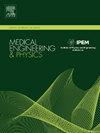预测人工椎间盘偏移后颈椎异位骨化的有限元研究
IF 2.3
4区 医学
Q3 ENGINEERING, BIOMEDICAL
引用次数: 0
摘要
异位骨化(HO)是颈椎全椎间盘置换术(TDR)的一个重要并发症,常导致融合,使运动保留的预期益处落空。虽然已知与HO形成相关的临床因素,但确切的生物力学机制尚不清楚。本研究旨在利用经验证的颈椎(C2-T1)在生理负荷下的有限元模型(FEM)预测C5-C6水平Mobi-C椎间盘置换术后HO的形成。结果显示,Mobi-C椎间盘使植入节段屈伸活动范围(ROM)增加了52%,而相邻节段则减少了2 - 5%。HO形成后,植入水平的ROM在屈曲和伸展时分别下降了67 - 76%,而相邻水平则适度增加了5 - 8%。此外,临近节段的椎间盘内压力在伸展时增加了高达60%,模拟了类似融合的行为。理想种植体位置的HO体积为678 mm³,偏移0.5 mm为760 mm³(+ 12%),偏移1mm为800 mm³(+ 17%)。本研究强调了Mobi-C放置对于减少HO形成、保持运动和减轻并发症的重要性,为临床实践提供了见解。本文章由计算机程序翻译,如有差异,请以英文原文为准。
Prediction of heterotopic ossification on the cervical spine with offset of the artificial disc – A finite element study
Heterotopic ossification (HO) is a significant complication of cervical total disc replacement (TDR), often leading to fusion and negating the intended benefits of motion preservation. Although clinical factors associated with HO formation are known, the exact biomechanical mechanism remains unclear. This study aims to predict HO formation after Mobi-C disc replacement at the C5-C6 level using a validated finite element model (FEM) of the cervical spine (C2-T1) under physiological loading. The results revealed that the Mobi-C disc increased the range of motion (ROM) at the implanted level by 52 % under flexion and extension, while adjacent levels exhibited a 2–5 % reduction. Following HO formation, ROM at the implanted level decreased by 67–76 % in flexion and extension, respectively, while adjacent levels showed a moderate increase of 5–8 %. Additionally, intradiscal pressure at the adjacent levels increased by up to 60 % in extension, mimicking fusion-like behavior. HO volume was 678 mm³ for the ideal implant position, to 760 mm³ (+12 %) for a 0.5 mm offset and 800 mm³ (+17 %) for a 1 mm offset. This study highlights the importance of Mobi-C placement to minimize HO formation, preserve motion, and mitigate complications, providing insights for clinical practice.
求助全文
通过发布文献求助,成功后即可免费获取论文全文。
去求助
来源期刊

Medical Engineering & Physics
工程技术-工程:生物医学
CiteScore
4.30
自引率
4.50%
发文量
172
审稿时长
3.0 months
期刊介绍:
Medical Engineering & Physics provides a forum for the publication of the latest developments in biomedical engineering, and reflects the essential multidisciplinary nature of the subject. The journal publishes in-depth critical reviews, scientific papers and technical notes. Our focus encompasses the application of the basic principles of physics and engineering to the development of medical devices and technology, with the ultimate aim of producing improvements in the quality of health care.Topics covered include biomechanics, biomaterials, mechanobiology, rehabilitation engineering, biomedical signal processing and medical device development. Medical Engineering & Physics aims to keep both engineers and clinicians abreast of the latest applications of technology to health care.
 求助内容:
求助内容: 应助结果提醒方式:
应助结果提醒方式:


